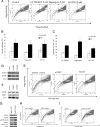Activation of the PTEN/mTOR/STAT3 pathway in breast cancer stem-like cells is required for viability and maintenance
- PMID: 17911267
- PMCID: PMC2042178
- DOI: 10.1073/pnas.0702596104
Activation of the PTEN/mTOR/STAT3 pathway in breast cancer stem-like cells is required for viability and maintenance
Erratum in
- Proc Natl Acad Sci U S A. 2007 Dec 4;104(49):19655
Abstract
Side-population (SP) cells within cancers and cell lines are rare cell populations known to enrich cancer stem-like cells. In this study, we characterized SP cells from the human breast cancer cell line MCF7 as a model for cancer stem-like cells. Compared with non-SP cells, MCF7 SP cells had higher colony-formation ability in vitro and greater tumorigenicity in vivo, suggesting that MCF7 SP cells enrich cancer stem-like cells. cDNA microarray analysis of the SP cells indicated higher expression of ATP-binding cassette transporters and genes involved in quiescence, which were confirmed by quantitative RT-PCR and flow cytometry cell cycle analysis. To identify signal pathways important for cancer stem-like cells, we analyzed cDNA microarray data and identified nine pathways that were altered in the SP cells. To analyze the protein signaling networks, we used reverse-phase signaling pathway protein microarray technology and identified three signaling proteins that are significantly different between MCF7 SP and non-SP cells. Notably, signaling of phosphatidylinositol 3-kinase (PI3K)/mammalian target of rapamycin (mTOR), signal transduction and activator of transcription (STAT3), and phosphatase and tensin homolog (PTEN) was confirmed to be critical for MCF7 SP cell survival and proliferation by pathway specific inhibitors, selected gene knockdown, and in vivo tumorigenicity assay. The STAT3 pathway was found to be positively regulated by mTOR signaling, whereas PTEN served as a negative regulator of both STAT3 and mTOR signaling. This study suggests the existence of prosurvival signaling pathways critical for cancer stem-like cell maintenance, which could be selectively targeted for inhibiting cancer stem-like cells for improved treatment.
Conflict of interest statement
The authors declare no conflict of interest.
Figures


References
-
- Lapidot T, Sirard C, Vormoor J, Murdoch B, Hoang T, Caceres-Cortes J, Minden M, Paterson B, Caligiuri MA, Dick JE. Nature. 1994;367:645–648. - PubMed
-
- Singh SK, Hawkins C, Clarke ID, Squire JA, Bayani J, Hide T, Henkelman RM, Cusimano MD, Dirks PB. Nature. 2004;432:396–401. - PubMed
-
- O'Brien CA, Pollett A, Gallinger S, Dick JE. Nature. 2007;445:106–110. - PubMed
-
- Ricci-Vitiani L, Lombardi DG, Pilozzi E, Biffoni M, Todaro M, Peschle C, De Maria R. Nature. 2007;445:111–115. - PubMed
Publication types
MeSH terms
Substances
Grants and funding
LinkOut - more resources
Full Text Sources
Other Literature Sources
Medical
Research Materials
Miscellaneous

